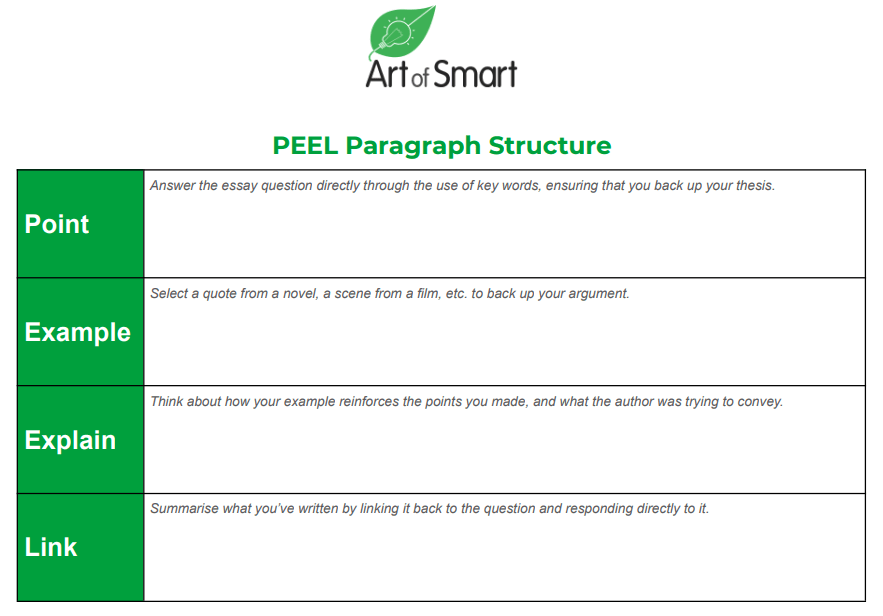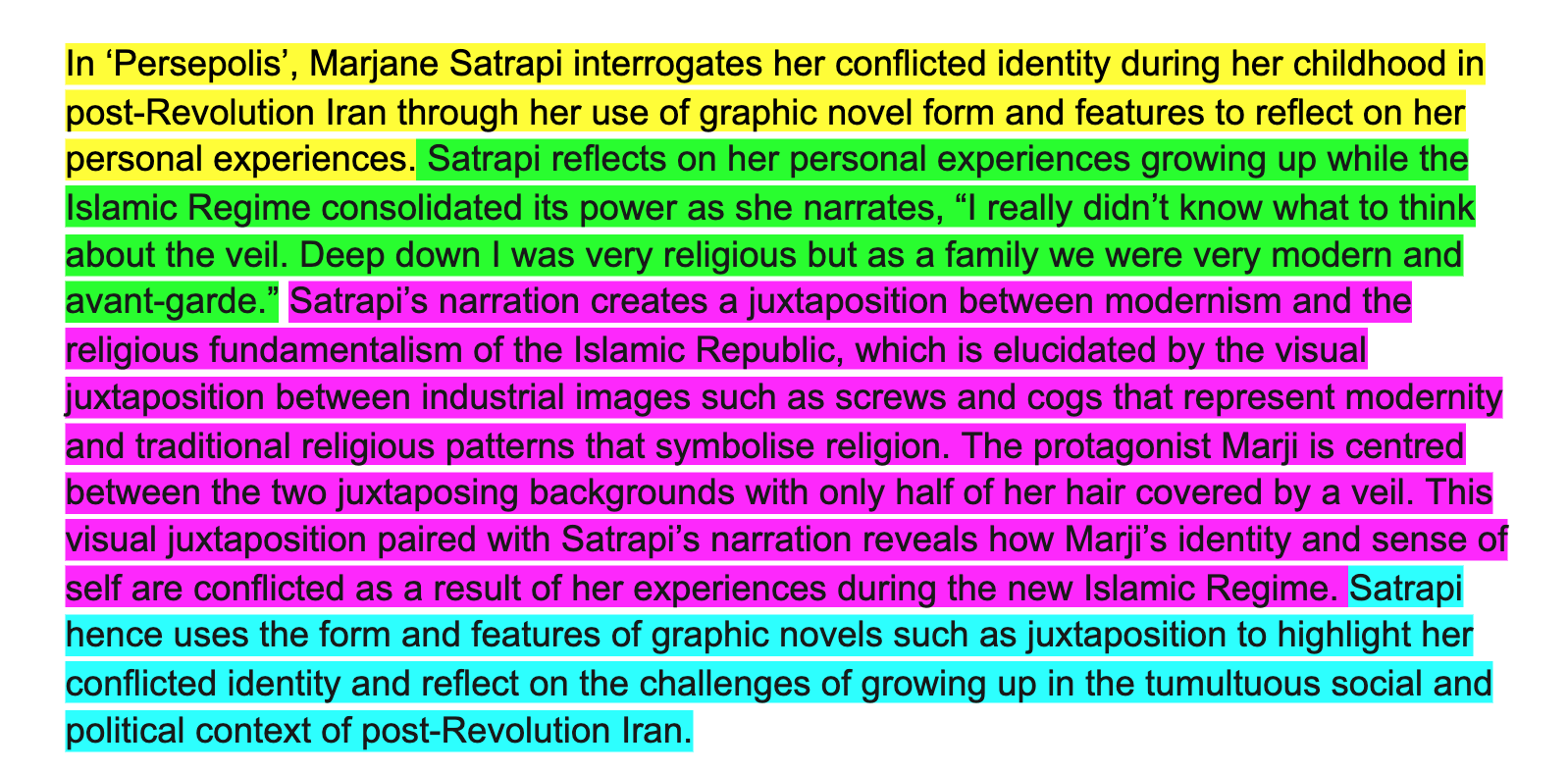Are you writing an English essay and feeling a little confused about how to structure your body paragraphs? Maybe you’ve heard about the PEEL paragraph structure but you’re unsure about how to use it.
If that’s the case, you’ve clicked on the right article!
We’ll unpack what the PEEL paragraph is and walk you through how to write one, using ‘Persepolis’ — a graphic novel by Marjane Satrapi, so that you can ace your next English essay!
What are you waiting for? Let’s dive in!
What is a PEEL paragraph?
Step 1: Identify Your Point
Step 2: Incorporate Your Example
Step 3: Explain How Your Example Supports Your Point
Step 4: Finish Off With Your Link
Constructing the PEEL Paragraph
What is a PEEL Paragraph?
PEEL is a mnemonic (a pattern or word that can help us remember an idea or concept) used to organise your writing and ensure that you’re focussing on a single clear argument in each paragraph.
This mnemonic stands for: Point, Example, Explain, Link.
Something to keep in mind is that PEEL is a quite generic structure and as your writing gets more advanced, it’ll start to look more like PEEEEEEL! This is because you’ll be including a lot of examples and explanations to build a strong, convincing argument.
Why should you use PEEL Paragraphs?
Each of these components of PEEL (Point, Example, Explain and Link) are super important when writing body paragraphs for English essays!
If you’re missing any one of these, it’ll be harder to get your point across, which means you won’t be able to achieve a high mark in your essay.
Are you trying to lift your marks for English? If so, fixing your essay structure is a great place to start! We have English tutors in the Hills District and all across Sydney who can provide a personalised improvement plan for you! We also have tutors in Queensland and Victoria (+ anywhere remotely!)
Using the PEEL structure will make sure that you’re covering each of these components, which will make your argument more convincing and help you achieve that top mark!
Step 1: Identify Your Point
Your paragraph should start with a sentence that establishes the point you’re trying to make and answers the essay question by using key words from the question.
The Point, or topic sentence, should be clear and succinct because this is what the marker is going to read first. If they don’t understand the Point, it weakens the rest of your argument.
For example, if you’re responding to the question, “How does ‘Persepolis’ explore Marji’s conflicted identity throughout her childhood in post-Revolution Iran?” your Point could be:
In ‘Persepolis’, Marjane Satrapi interrogates her conflicted identity during her childhood in post-Revolution Iran through her use of graphic novel form and features to reflect on her personal experiences.
In this sentence, “through her use of the graphic novel form and features” directly answers the “How” part of the question. The incorporation of keywords like “conflicted identity” and “post-Revolution Iran” also clearly respond to the essay question.
The sentence essentially tells the marker what this paragraph is about and what point it’s trying to make.
Keep in mind that even though the PEEL structure only has four key components, you don’t have to restrict yourself to four sentences!
If your Point is getting too long and wordy, it might be a good idea to split it into two sentences so that it flows better.
It’s not too late to get individual support on your writing. Our Sydney English Tutors will tailor 1-1 sessions that suit your specific needs. Sessions can be held in your own home or online.
Step 2: Incorporate Your Example
Example is where you bring in evidence from your text to support your Point. Depending on your text, the Example can be a quote, image, scene from a film, or more.
The key to finding good examples is to make sure that there are plenty of techniques to unpack! It’s also really important to find quotes that are unique and uncommon so that you stand out from other students.
Backing up your argument with examples that haven’t been used by everyone else adds a lot of depth and strength to your Point!
When you’re including the Example in your body paragraph, make sure you contextualise it.
A little sentence or even just a few words about the broader plot and context behind the quote can go a long way! It shows that you’re engaging with the text on a deeper level.
For example, going back to our ‘Persepolis’ example, a good Example to support the Point would be:
Satrapi reflects on her personal experiences growing up while the Islamic Regime consolidated its power as she narrates, “I really didn’t know what to think about the veil. Deep down I was very religious but as a family we were very modern and avant-garde.”
One thing to note here is that ‘Persepolis’ is a graphic novel memoir, so even though the example shows a quote, make sure to discuss and analyse both the quote and the visual!
Also, notice how the Example also adds a sentence about how “Marjane Satrapi reflects on her personal experiences growing up while the Islamic Regime gained and consolidated power.” This situates the example within the text as a whole and also within its historical context.
Step 3: Explain How Your Example Supports Your Point
Now that you have your Example, you need to Explain how it supports the Point.
This is where your analysis really shines! You’ll flesh out your key points, introduce different techniques and go into greater detail about the deeper meanings of the text and your Example.
When you’re trying to Explain, it can be easy to just slip into recounting the plot but it’s super important to steer clear of recounting! You can avoid doing this by always bringing your discussion back to the Point.
Going back to our ‘Persepolis’ example, here’s what your Explanation would be like if you’re only retelling/recounting:
Her narration uses juxtaposition and symbolism to demonstrate how Marji is caught between the oppressive and extremist religious ideas of the regime and her family’s modern and avant-garde ideas, which shows how her identity is conflicted as she grows up in post-Revolution Iran.
Here, as we Explain the Example, we’re mostly retelling what’s already been said in the quote, but with a brief mention of techniques and the Point.
Instead, you want to make sure you flesh out the relationship between the Example, the techniques it uses, and the effect/significance of this. This would look more like:
Satrapi’s narration creates a juxtaposition between modernism and the religious fundamentalism of the Islamic Republic, which is elucidated by the visual juxtaposition between industrial images such as screws and cogs that represent modernity and traditional religious patterns that symbolise religion. The protagonist Marji is centred between the two juxtaposing backgrounds with only half of her hair covered by a veil. This visual juxtaposition paired with Satrapi’s narration reveals how Marji’s identity and sense of self are conflicted as a result of her experiences during the new Islamic Regime.
Step 4: Finish Off With Your Link
The final step is to just wrap it all up! Your Link should sum up what you’ve discussed in your body paragraph and tie it up so that it’s cohesive and clearly organised.
But the Link shouldn’t just repeat your Point! It should also link back to the essay question and directly respond to it.
Using our ‘Persepolis’ example, here’s what the Link could look like:
Satrapi hence uses the form and features of graphic novels such as juxtaposition to highlight her conflicted identity and reflect on the challenges of growing up in the tumultuous social and political context of post-Revolution Iran.
We’ve taken a look at the four steps of writing PEEL paragraphs and now it’s time to put it all together!
Constructing the PEEL Paragraph
When you’re writing your body paragraph, do a little checklist to see if you’ve included all four components of PEEL. Feel free to go more in-depth with your Example and Explanation so that it looks more like a PEEEEEEL paragraph!
Here’s what your final PEEL Paragraph might look like:
Each component of PEEL has been highlighted for your convenience, Point (yellow), Example (green), Explanation (purple), Link (blue).
So there you have it! We’ve looked at the four easy steps that will help you write a PEEL paragraph. Now it’s time for you to ace your next English essay.
If you’d prefer to use a different paragraph structure, then you should check out how the STEEL paragraph structure, TEEL paragraph structure or the PETAL paragraph structure works!
On the hunt for other English resources?
Check out some of our other articles and guides below:
- How to Elevate Your Essays in English Using the ‘Thesis + 3’ Technique
- The Top 3 Tips For Improving Your English Writing Skills
- A Step-by-Step Guide to Analysing English Texts (Textual Analysis Examples Included!)
- HSC State Ranker’s #1 Strategy for Acing Unseen Essay Questions in HSC English
Heads up! NSW English has changed its syllabus – we’ve shared the major updates you need to know about!
Looking for some extra help with the PEEL paragraph structure?
We have an incredible team of English tutors and mentors!
We can help you master your English text and ace your upcoming English assessments with personalised lessons conducted one-on-one in your home, online or at one of our state of the art campuses in Hornsby or the Hills!
We’ve supported over 8,000 students over the last 11 years, and on average our students score mark improvements of over 20%!
To find out more and get started with an inspirational English tutor and mentor, get in touch today or give us a ring on 1300 267 888!
Maitreyi Kulkarni is a Content Writer at Art of Smart Education and is currently studying a Bachelor of Media and Communications (Public Relations and Social Media) at Macquarie University. She loves writing just about anything from articles to poetry, and has also had one of her articles published with the ABC. When she’s not writing up a storm, she can be found reading, bingeing sitcoms, or playing the guitar.










